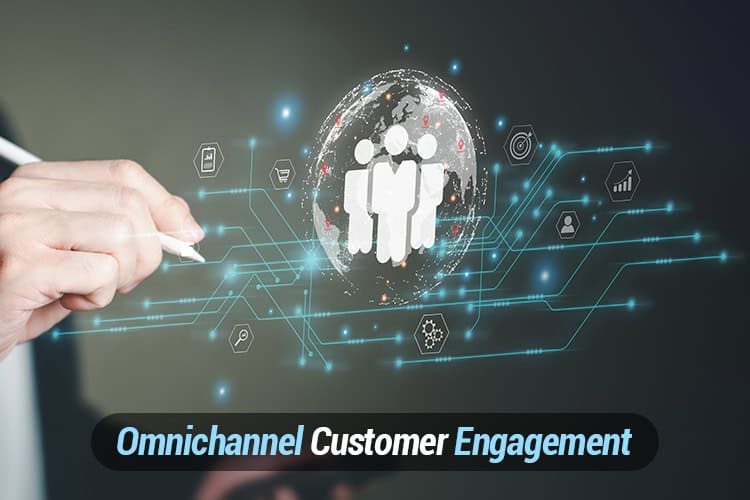Not all businesses have the ability or the resources to effectively engage customers across multiple channels. This, however, is crucial for businesses that are trying to maintain a competitive edge. The concept of omnichannel customer engagement has been around for a while now, yet not all companies utilize it correctly or at all.
In this article, we’ll delve into what omnichannel customer engagement entails, its importance to businesses, the benefits it offers, challenges faced, and most importantly, how to create an effective omnichannel customer engagement strategy.
Table of Contents
Understanding Omnichannel Customer Engagement
Omnichannel customer engagement isn’t just a buzzword; it’s a strategic approach to customer interaction that emphasizes the seamless integration of multiple channels to deliver a consistent and personalized experience. Whether it’s through social media, email, chat, phone, or in-person interactions, businesses must ensure that customers receive the same level of service and attention across all touchpoints.
Why is an Omnichannel Customer Engagement Strategy Important for Businesses?
Omnichannel customer engagement carries huge significance in the call center world. Customers today expect businesses to meet them on their preferred platforms and provide a seamless experience throughout their journey. This is why an omnichannel strategy is crucial for businesses.
Personalized Customer Experience: By leveraging data insights from various channels, businesses can tailor interactions to suit individual preferences, leading to higher customer satisfaction and loyalty.
Exceed Customer Expectations: Meeting customers on their preferred platforms and providing consistent service at every touchpoint helps in surpassing their expectations, fostering loyalty and advocacy.
Build Customer Loyalty: When customers receive a seamless and personalized experience, they are more likely to become loyal advocates for your brand, driving more business and referrals.
Increased Customer Retention: By addressing customer needs proactively and providing convenient communication options, businesses can enhance customer retention rates significantly.
Benefits of omnichannel customer engagement
So what are the benefits of omnichannel customer engagement
Effortless Customer Communication
Effortless customer communication is at the core of omnichannel engagement. By offering customers multiple channels to interact with your brand, such as email, social media, chat, and phone, you make it easier for them to reach out in a way that suits their preferences and convenience. This accessibility leads to smoother interactions, reduced friction, and a more satisfying customer experience.
Personalization at Scale
One of the key advantages of omnichannel engagement is the ability to personalize experiences at scale. By leveraging automation and data analytics, businesses can gather valuable insights into customer behavior, preferences, and past interactions across multiple touchpoints. Armed with this information, they can tailor their communications and offerings to individual customers, delivering relevant content, recommendations, and promotions.
Improved Customer Retention and Loyalty
Building long-term relationships with customers is essential for sustained success, and omnichannel engagement plays a pivotal role in this regard. By providing consistent service and meaningful interactions across various channels, businesses can cultivate trust and loyalty among their customer base.
Higher Engagement and Conversion Rates
A cohesive omnichannel strategy ensures that customers remain engaged throughout their journey, from initial discovery to post-purchase support. By offering seamless transitions between channels and maintaining a consistent brand presence, businesses can keep customers actively involved and interested in their offerings. This sustained engagement not only strengthens your brand but also increases the likelihood of conversion.
Granular Insights and Analytics
Omnichannel engagement provides businesses with invaluable insights into customer behavior and preferences through granular data analytics. Centralizing customer data ensures consistency. A single source of truth enables teams to operate cohesively and deliver personalized experiences. This data-driven approach enables informed decision-making and targeted marketing efforts, which allows businesses to optimize their strategies for maximum impact.
Customer Segmentation
Effective customer segmentation is essential for delivering tailored messaging and personalized experiences, and omnichannel engagement offers unparalleled opportunities in this regard. By segmenting their audience based on demographics, behavior, preferences, and purchase history, businesses can create targeted communication strategies that resonate with specific customer segments. Associate consumer data with their profiles across channels and access this data during interactions.
“Transforming customer engagement is not just about being present; it’s about seamlessly integrating channels and simplifying operations. With NobelBiz OMN+, we empower businesses to navigate the complexities of omnichannel communication effortlessly, from orchestrating campaigns to monitoring performance, all within a unified dashboard.” – Christian Montes, Executive Vice President of Client Operations @NobelBiz
Challenges in Creating an Omnichannel Customer Engagement Strategy
While the benefits of omnichannel customer engagement are clear, implementing and maintaining a successful strategy comes with its own set of challenges:
Unifying Customer Data:
Integrating data from disparate sources without creating silos can be a daunting task, requiring robust data management systems and processes.
Example: A call center might receive customer queries through phone calls and social media. If these communication channels are managed separately, the agents might not have access to the customer’s full history, leading to redundant conversations and frustration on the customer’s part.
Solution: Implement a robust Customer Relationship Management (CRM) system that integrates all customer interaction data into a single platform. This can enable agents to access comprehensive customer histories, ensuring that they are well-informed and can provide consistent and efficient service. Tools like Salesforce, Zoho or Zendesk can be utilized to amalgamate data and provide a unified customer view.
 Facilitating Effective Communication and Avoiding Channel Complexity:
Facilitating Effective Communication and Avoiding Channel Complexity:
Balancing the use of multiple channels without overwhelming customers or creating complexity requires careful planning and execution, ensuring that messages are timely, relevant, and consistent across all touchpoints.
Example: A call center might use email, SMS, phone calls, and social media to engage with customers. Without a clear strategy, this can lead to customers receiving mixed messages or duplicate communications across various channels.
Solution: Develop a channel management strategy that defines the purpose and tone for each channel and integrates channel usage into the CRM. For example, SMS might be reserved for urgent notifications, while emails are used for detailed follow-up content. Implementing channel preference management allows customers to choose how they want to be contacted, as a result, enhancing their experience and satisfaction.
Creating Consistency Across Channels:
Maintaining brand consistency and messaging coherence across diverse channels is crucial for building trust and credibility, requiring clear guidelines and oversight.
Example: Promotional offers might be communicated differently on social media compared to email campaigns, leading to confusion and potentially diluting brand trust.
Solution: Establish clear communication guidelines and regular training for all team members. Utilize templates and predefined scripts to maintain consistency. Regular audits and feedback loops can help ensure that all channels stay aligned with the brand’s messaging strategy.
 Risk of Overdoing Personalization:
Risk of Overdoing Personalization:
While personalization is key to engagement, there’s a fine line between being helpful and intrusive. Businesses must create the right balance to avoid alienating customers and damaging relationships.
Example: Using detailed personal information inappropriately or too frequently in communications can make customers feel their privacy is being invaded.
Solution: Set boundaries for personalization by using customer data to inform customers without overstepping. Personalization should be based on customer preferences and past interactions, focusing on relevance and adding value. For instance, offering a discount on a customer’s birthday is a positive use of personal data, while referencing their recent location check-ins isn’t.
 Limitations with Technological Infrastructure:
Limitations with Technological Infrastructure:
Legacy systems and technological constraints may hinder the seamless integration of channels, requiring investments in modern solutions and platforms.
Example: A legacy call center system might not integrate well with newer digital channels like messaging apps or artificial intelligence-driven chatbots.
Solution: Invest in upgrading or replacing outdated systems. Embrace cloud-based solutions that offer scalability and integration capabilities with multiple channels and data sources. Partnerships with technology providers like Microsoft or Google can provide access to advanced tools that support an integrated engagement strategy.
Evolving Customer Expectations:
As customer preferences and behaviors evolve, businesses must continually adapt their omnichannel strategies to stay relevant and competitive.
Example: Customers increasingly expect real-time responses and proactive service across all channels.
Solution: Stay agile by continually gathering and analyzing customer feedback to understand changing preferences. Implement advanced analytics and AI tools to anticipate customer needs and automate responses where appropriate. Training programs should be regularly updated to keep staff aware of new tools and strategies for customer engagement.
How to Create an Effective Omnichannel Customer Engagement Strategy
Building a successful omnichannel customer engagement strategy requires careful planning and execution. Here’s a step-by-step guide to help you get started:
1. Determine Customer Channels
The first step in creating an effective omnichannel customer engagement strategy is to identify the channels preferred by your target audience. This involves conducting comprehensive data analysis, market research, and gathering insights from customer feedback. By understanding where your customers are most active and receptive, you can prioritize channels that offer the greatest potential for engagement and interaction.
2. Map the Customer Journey
Once you’ve identified the preferred channels, the next step is to map the customer journey from awareness to advocacy. This involves understanding the various channels and interactions that customers have with your brand throughout their journey. By mapping out the customer journey, you can identify pain points, opportunities for optimization, and moments of truth where you can make a significant impact on the customer experience.
3. Create a Strategy Across Channels
With a clear understanding of the preferred channels and the customer journey, the next step is to develop a cohesive strategy that integrates various channels to deliver a seamless and personalized experience. This involves aligning messaging and interactions with customer needs and preferences, ensuring consistency and relevance across all touchpoints.
4. Ensure Unified Messaging
Maintaining consistency in messaging and branding across all channels is essential for reinforcing brand identity and building trust with customers. This involves establishing clear guidelines and standards for communication, ensuring that messaging is cohesive, relevant, and aligned with brand values.
5. Invest in Your Team
Empowering your team is crucial for delivering exceptional service and maximizing the potential of omnichannel engagement. This involves providing training and support to equip team members with the knowledge, skills, and tools they need to succeed. Whether it’s customer service representatives, sales associates, or marketing professionals, investing in your team fosters a culture of customer-centricity and continuous improvement, ensuring that everyone is aligned with the overarching customer engagement strategy.
6. Use an Omnichannel Platform
Investing in a robust omnichannel customer engagement platform is essential for streamlining communication, data management, and analytics. A comprehensive platform provides a centralized hub for managing customer interactions and insights, enabling seamless communication and collaboration across teams and departments.
 Nobelbiz is known for its scalable, reliable, and comprehensive set of features, Nobelbiz stands out as a leading provider of Omnichannel Contact Center Software Platform. With a focus on innovation and customer-centricity, Nobelbiz empowers businesses to deliver exceptional experiences to their customers while driving operational excellence.
Nobelbiz is known for its scalable, reliable, and comprehensive set of features, Nobelbiz stands out as a leading provider of Omnichannel Contact Center Software Platform. With a focus on innovation and customer-centricity, Nobelbiz empowers businesses to deliver exceptional experiences to their customers while driving operational excellence.

Brad Dashnaw
”Their software is easy to use, easy to implement, and able to be integrated with our own platforms. We were able to train people easily, and deploy it to their computers in their home offices to keep productivity going!”
Best Practices for Adopting an Omnichannel Customer Engagement Strategy
In addition to the foundational steps outlined above, here are some best practices to help you optimize your omnichannel strategy for maximum impact:
Scale Channels as Demand Increases: Start with a few key channels and expand gradually based on customer feedback and demand, prioritizing quality over quantity.
Utilize Self-Help Tools: Implement self-service options such as FAQs, chatbots, and knowledge bases to empower customers and reduce support overhead, freeing up resources for more complex inquiries and interactions.
“Technology empowers individuals by enabling them to harness its capabilities to enhance their performance within a contact center environment, ensuring that it serves their needs and optimizes their roles.” – Chris Robinson, Founder at Awaken
Keep Customers Updated: Provide real-time updates and proactive communication to keep customers informed and engaged throughout their journey, leveraging automation and segmentation to deliver timely and relevant messages.
Adopt a Unified CXM Platform: Invest in a comprehensive Customer Experience Management (CXM) platform that integrates with existing systems and provides a centralized view of customer interactions, enabling seamless communication and collaboration across teams and departments.
Nobelbiz: Leading the Way in Omnichannel Customer Engagement Platforms:
As a pioneer in the field of Omnichannel Customer Engagement Platforms, Nobelbiz stands at the forefront of innovation, reliability, and customer-centricity. With a proven track record of delivering scalable, customizable, and feature-rich solutions, Nobelbiz empowers businesses to transform their customer engagement strategies and achieve tangible business outcomes. Key strengths of Nobelbiz include:
- Scalability with No Strings Attached: The pay-as-you-go model implies that resources can be allocated according to your needs. This can help contact centers tackle seasonality and unpredicted activity spikes with virtually no infrastructure update. Resource management, hardware updates, and operations scaling (such as onboarding new agents) are taken off the shoulders of the management team.
- CRM Connectors and API Integrations: Updating CRM client profiles in real-time just got easier. The CRM connectors will allow quick action buttons inside the Agent Interface, offering agents the hassle-free experience of updating CRM data without leaving the primary contact center dashboard.
- Proprietary Voice Carrier Network: The NobelBiz Voice Carrier Network is one of the best VoIP Interconnected Providers in the industry, with multiple worldwide redundancies for uninterrupted uptime, delivering the best possible voice quality at a fair price.
- Going Beyond 24/7/365 Support: With 20 years of experience in the Contact Center industry, both as a software and telecom provider, NobelBiz learned a thing or two about how to best serve the interests of our clients by offering outstanding customer support.
Mastering omnichannel customer engagement is essential for businesses looking to thrive in today’s competitive landscape. By understanding the principles, benefits, challenges, and best practices outlined in this article, businesses can embark on their journey towards unlocking the full potential of omnichannel engagement, driving loyalty, retention, and revenue growth. With a strategic approach and a commitment to continuous improvement, companies can create seamless and personalized experiences that resonate with customers and put their brand on the customer map.

Michael McGuire is a contact center industry expert with almost two decades of experience in the space. His experience includes roles as Director of Contact Center Digital Transformation at NobelBiz, and as Director of Operations at FLS Connect, managing multiple call centers. As President of Anomaly Squared and Targeted Metrics, Michael successfully transitioned companies into remote operations and significantly boosted revenues. With a strong background in customer service, leadership, strategic planning, and operations management, Michael excels in driving growth and innovation in the call center space.
Mike is also a proud Board Member for R.E.A.C.H Trade Group, promoting consumer protection and satisfaction and Co-host of the Off Skripted Podcast – a show about Life, Call Centers and everything in between.





